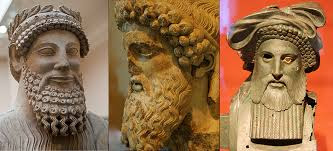The Romans had adapted to a very Greek architecture for their
own purposes and created new styles in architecture as well. Vaults and arches
and an intimate knowledge of building materials enabled them to achieve great
success in constructing and making structures that could be used by the
population.
Roman literature had its very birth influenced from Greek
authors. The earliest works that are possessed till now are of historical epics
telling the earliest military history of Rome.
While the republic expanded, authors began to make poetry, comedy,
history and tragedy.
The paintings that
were found had Etruscan influences, especially in the practice of political
paintings. . Music was a part of life. Public and private events had music. Great attention was paid to physical
activities and sports and games were intricately woven into Roman culture.
There is evidence of the
existence of a substantial garment industry employing dyers and professional tailors. The main
fabric was wool, later followed by linen, cotton and silk. Dyeing was done
primarily from an extract of the murex sea snail harvested in the Eastern
Mediterranean.
The basic garments used
in Roman clothing were the Tunic, Toga, Cloak and the Stola, which was worn by
women.
Men generally wore
two garments, the Tunica and the Toga, the Tunica being a short woolen under garment
with short sleeves. In cold weather they were likely to wear two or three
Tunics, in which case the one nearest the body, functioning as a vest, would be
the Subucula.
The Types of Tunics were
Tunica Augusti Clavi: decorated with narrow Purple Stripes and worn by Knights
and Legislators; Tunica Laticlavia: a much wider Clavi, reserved for wear by
Senators; Tunica Palmata: made of purple silk Embroidered with Gold Thread,
depicting scenes of Military Campaigns.
It was worn with Toga Picta; Tunica Recta: worn by both Men and Women during
Marriage; Tunica Talaris: a full length Tunic which came into vogue during the
2nd Century.
The Toga was allowed to be worn only by Free
Roman citizens. Foreigners or even exiled citizens could not appear in public
wearing a Toga.
The Toga was basically a large Blanket, draped
over the body, leaving one arm free. It usually spanned between 2.5 to 3 meters
in length, some reaching up to 5.5 meters long, and up to 2 meters at its widest.
Types of Togas:- Toga Praetexta: worn by all
free Sons and Daughters of nobility until the age of 16 and also by Old
Senators. It was White with a Purple Border; Toga Pura or Viriles: a plain
natural Toga made od Unbleached Wool and worn by all Roman citizens over 16;
Toga Candida: similar to Toga Pura, but of Bleached Wool, usually worn by
candidates for Public Office, without Tunica; Toga Picta: worn on special occasions
by High Ranking Officials. It was Purple in colour with Golden Embroidery; Toga
Pulla: a Black or Dark coloured toga worn for Mourning.
Paludamentum (Cloak): a Cloak or Cape fastened
at one shoulder, worn by Military commanders and (less often) by their troops.
It was generally Crimson, Scarlet or Purple
or sometimes White. It was fastened at the shoulder with a Clasp called
the Fibula, whose size and form varied through time. Putting on the
Paludamentum was a ceremonial act on setting out for War.
Stola: The basic female garment was the Stola,
which was Long Tunic reaching to the ground. It could bave long or short
sleeves, or be entirely sleeveless. The Stola was generally worn over another
Tunic, the Tunica Interior.
As an Over garment women in the early days of
the Republic wore the Recinium, a simple square Cloak, covering the shoulders.
Later the Recinium was replaced by the Palla.
The Palla was there
as a Wrap for the females and they had to necessarily wear it while in the
outdoors. It was either Simple or Decorated.
Beards: The tradition of intricately groomed beards was quite common
among the Greeks, Etruscans and Romans. The fashion of Shaving was adopted by
the Greeks during the age of Alexander and was introduced by them to the
Romans. In the Late Republic it was very fashionable for young Romans to keep a
small, well-groomed beard known as Barbula.
Hairstyles: Roman women’s hair was plaited in
braids and tied at the back of the head. Men’s hairstyle was simple curled or
straight hairs.










No comments:
Post a Comment